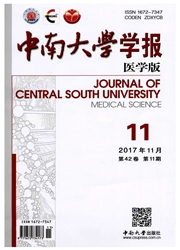

 中文摘要:
中文摘要:
目的:观察淫羊藿总黄酮对去卵巢大鼠下丘脑和海马雌激素受体α及βmRNA表达的影响,探讨其治疗绝经后骨质疏松的作用机制。方法:将10~11月龄SD雌性大鼠48只,随机分为假手术组、去卵巢模型组、淫羊藿总黄酮组和雌二醇(E2)组。以双侧卵巢切除法建立大鼠骨质疏松模型。淫羊藿总黄酮组、E2组分别用淫羊藿总黄酮、E2给药4个月,采用RT-PCR法检测各组下丘脑和海马ERα,ERβmRNA的表达。结果:大鼠卵巢切除后,血E2水平、椎骨骨密度、子宫湿重、下丘脑和海马ERα,ERβmRNA的表达均明显下降。E2治疗后血E2水平、椎骨骨密度、子宫湿重升高,下丘脑和海马ERβmRNA的表达均明显下降,下丘脑和海马ERβmRNA的表达无明显改变。淫羊藿总黄酮治疗后,血E2水平、椎骨骨密度、下丘脑和海马ERα,ERβmRNA的表达均明显升高,子宫湿重无明显改变。结论:淫羊藿总黄酮对切除卵巢所致的骨质疏松大鼠有防治作用,对子宫无不良反应;其机制可能与其选择性上调下丘脑和海马ERα,ERβmRNA的表达有关。
 英文摘要:
英文摘要:
Objective To explore the effect of total flavonoids of Epimedium sagittatum(TFE) on the mRNA expressions of the estrogen receptor alpha(ERα) and estrogen receptor beta(ERβ) in hippocampus and hypothalamus in ovariectomized(OVX) Sprague-Dawley(SD) rats,and the mechanism of TFE against postmenopausal osteoporosis.Methods Forty-eight female SD rats,aged 10-11 months old,were randomly divided into 4 groups:a sham group,an ovariectomy group(rats were bilaterally ovariectomized),a TFE group,and a 17β-estradiol group(rats were fed with TFE and 17β-estradiol for 4 months,respectively).The RT-PCR was performed to determine the mRNA expression of ERα and ERβ in hypothalamus and hippocampus.Results Serum estradiol level,bone mineral density(BMD) of vertebra,wet weight of uterus,and the mRNA expressions of ERα and ERβ in hypothalamus and hippocampus were markedly decreased in OVX rats,all of which were reversed by 17β-estradiol treatment except the mRNA expression of ERβ.Similar results were achieved by TFE treatment except the wet weight of uterus.Conclusion TFE can improve BMD of vertebra in the OVX rats without side effects on the uterus.The mechanism may be related to increasing the mRNA expressions of ERα and ERβ in hypothalamus and hippocampus.
 同期刊论文项目
同期刊论文项目
 同项目期刊论文
同项目期刊论文
 期刊信息
期刊信息
